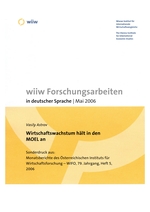Wirtschaftswachstum hält in den MOEL an
wiiw Research Report in German language No. 2006-05, May 2006
Zusammenfassung
Trotz der Konjunkturflaute in den Ländern der EU-15 und der Aufwertungen in einigen Ländern verzeichneten die mittel- und osteuropäischen Länder (MOEL) 2005 wieder ein robustes Wachstum. In den neuen EU-Ländern wurde es primär durch die Exportexpansion, in den anderen MOEL vor allem durch den boomenden Konsum getragen. Die Wirtschaftserfolge der neuen EU-Länder, aber auch der Beitrittsländer Bulgarien und Rumänien basieren im Wesentlichen auf der erfolgreichen Umstrukturierung dank massiver Zuflüsse von ausländischen Direktinvestitionen. In den westlichen Balkanländern verbessern sich die politische Stabilität und die Aussichten für die EU Integration zusehends, während Russland und die Ukraine nach wie vor von der Konjunktur auf dem Weltmarkt für Energie und Metalle abhängig sind.
Nachdem die Umstrukturierung der Industrie weitgehend abgeschlossen ist, trat erstmals eine leichte Entspannung auf dem Arbeitsmarkt der neuen EU-Länder ein. Gleichzeitig ist die Arbeitslosigkeit in Südosteuropa jedoch weiterhin sehr hoch und dürfte durch die bevorstehenden Umstrukturierungsmaßnahmen sogar noch steigen.
Obwohl die Exporte einiger neuer EU-Staaten dank der Verbesserung der Produktqualität kräftig expandieren, bleibt ihre Außenposition wegen der Gewinne aus den Direktinvestitionen stark defizitär. In Südosteuropa hat der Konsumboom eine rasante Zunahme der privaten Auslandsverschuldung zur Folge.
Mit der erwarteten leichten Belebung der Konjunktur in der EU-15 und der Verbesserung der Wettbewerbsfähigkeit der neuen EU-Länder wird sich das robuste Wirtschaftswachstum in den kommenden Jahren fortsetzen und nach wie vor um 2 bis 3 Prozentpunkte über der Rate in Westeuropa liegen. Die jüngsten Erfolge in der Konsolidierung der öffentlichen Haushalte drückten das Budgetdefizit der meisten Länder unter die Maastricht-Marke von 3% für den Eintritt in die Währungsunion. Die verhältnismäßig hohe Inflation könnte sich aber in mehreren Fällen als problematisch erweisen. Slowenien wird somit voraussichtlich als einziges neues EU-Land die gemeinsame Währung bereits Anfang 2007 übernehmen.
In den EU-Beitrittsländern Bulgarien und Rumänien ist mit einer Fortsetzung der derzeitigen Trends zu rechnen. Die Aussichten für die anderen Länder Südosteuropas hängen entscheidend von der Bewältigung mehrerer politischer und institutioneller Probleme ab. Zunehmend werden hier die Zuflüsse an ausländischen Direktinvestitionen die ausländische Finanzhilfe für Sicherheitsversorgung, Wiederaufbau und Einkommensunterstützung ersetzen.
Die Erwartung eines weiterhin hohen Rohölpreises und die Festigung der politischen Stabilität lassen für Russland auch in den kommenden Jahren ein Wirtschaftswachstum von 6% erwarten. Dagegen sind selbst die kurzfristigen Aussichten für die Ukraine mit einer Reihe von großen Unsicherheiten etwa bezüglich der politischen Stabilität und der Energiepreisentwicklung behaftet.
English Summary
The Economic Boom in CEE Continues Despite an economic slack in the EU-15 and, in many cases, the revaluated currencies, the Central and East European (CEE) countries achieved a sturdy growth again in 2005. This was primarily due to increased exports in the new EU member states and, throughout the remainder of CEE, as a result of booming consumption. The economic accomplishments of the new EU member states and also those of the acceding countries Bulgaria and Romania are largely based on successful restructuring, thanks to a massive influx of foreign direct investment (FDI). The western Balkan countries are increasingly benefiting from greater political stability and improved chances of an EU integration, whereas Russia and Ukraine continue to be dependent on the world market economic situation as regards energy and metals. For the first time, the largely completed restructuring of industries in the new EU member states resulted in a slight easing of tension within the labour market. Simultaneously, however, unemployment remains very high in many Southern European countries and, in view of forthcoming restructuring, may rise further. Despite an impressive growth of exports in many new EU member states, sustained increasingly by improved quality standards, the external position of these countries remains high in deficit, in view of FDI-related profit. In Southeast Europe, the boom in consumption has resulted in a breakneck increase in private foreign indebtedness.
The anticipated slight stimulation of economic activity within the EU-15, as well as the increasing competitive capacity of the new EU member states, will also enable a continuity of the latter's sturdy economic growth in the years to come. This growth will continue to be 2 to 3 percentage points above the level of Western Europe. The most recent consolidation achievements in the field of public finances in the majority of these countries enabled a lowering of their budget deficits below the 3 percent mark, as required by the Maastricht criterion for joining the European Monetary Union. However, relatively high inflation could prove to be problematic in several cases. Thus, Slovenia will presumably be the only new EU country to already adopt the euro at the beginning of 2007. A continuation of current trends is to be expected in the EU acceding countries Bulgaria and Romania. The prospects of the remainder of the countries in Southeast Europe largely depends on the surmounting of multiple political and institutional problems. However, FDI influx will increasingly replace foreign financial aid, with a view to providing security, reconstruction and revenue support. Favourable forecasts regarding crude oil prices and the strengthening of political stability in Russia will allow for the current growth rate of approximately 6 per cent to be sustained in the years to come. In contrast, even short-term prospects concerning Ukraine are encumbered with great uncertainties which, among other things, relate to questions of political stability and the level of energy prices.
Keywords: transitional economies, comparative study, macroeconomic forecast, macroeconomic analysis
JEL classification: P2, O57, E17
Countries covered: Albania, Bosnia and Herzegovina, Bulgaria, Croatia, Czechia, Estonia, Hungary, Latvia, Lithuania, North Macedonia, Montenegro, Poland, Romania, Russia, Serbia and Montenegro, Slovakia, Slovenia, Ukraine, Baltic States, SEE, Visegrad countries
Research Areas: Macroeconomic Analysis and Policy, Labour, Migration and Income Distribution, International Trade, Competitiveness and FDI
